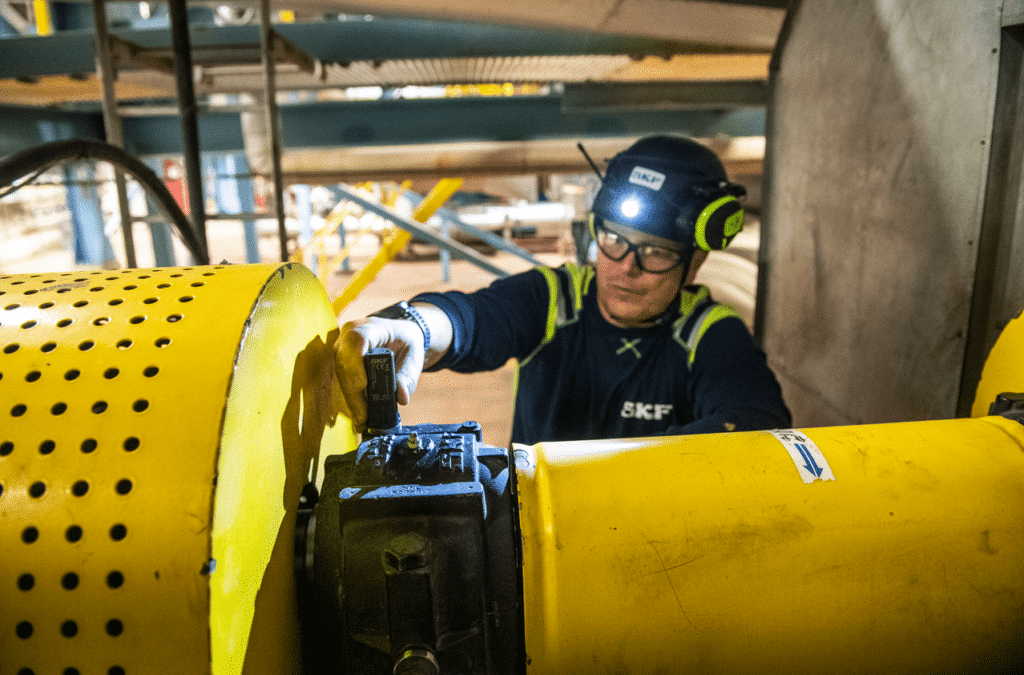SKF is advocating for a predictive maintenance approach in the mining industry, which the company says will help miners make informed decisions in real time.
The mining industry has historically been reactionary in its maintenance approach says Vish Arora, SKF’s Head of Connected Technology, waiting until equipment breaks down before taking action. This approach has several drawbacks, including increased downtime due to maintenance work being carried out only when machines fail, higher maintenance costs that require more resources to repair or replace machines, and safety hazards that can result in worker injuries. He explains that this approach is problematic and highlights the need for a more proactive maintenance strategy.
SKF, a global provider of bearings, seals, lubrication systems, and condition monitoring solutions, is advocating for a predictive maintenance approach that utilises condition monitoring to enhance machine performance. Vish recently discussed the advantages that the mining industry can reap by adopting this approach to equipment maintenance.
Vish explained that SKF has simplified this approach for end-users, breaking it down into four components – connect, detect, inform and improve. The first step is to identify the assets based on criticality and select the right technology based on application requirement. Once these “assets” are connected with suitable technology , it generate insights on the condition, operation, and performance of the machine.
SKF highlighted that some of the barriers customers face when being introduced to new technology is getting started, which is often related to application assessment and selection of technology. However, they offer a solution by tasking an expert to conduct this condition maintenance assessment. This ensures the user is properly connected and has a better understanding of the process.
Once the technology is connected and the data begins to flow, they enter the detection phase. According to Vish, it is essential to set up the technology properly by having the right database setups that can capture all the failure modes based on the application being monitored. He highlights “the detection phase is where you corelate your process data and your condition data to deliver a proper performance assessment.” SKF offers multiple ways of data handling, be local on-premises solutions or safe and secure cloud hosting, always making it flexible and accessible. SKF also offers Remote Monitoring Services, where experienced analysts conduct data diagnosis and attend daily alarms, providing detailed report and recommendations for corrective actions. In Vish’s words, “SKF does the real work for the user.”
The inform phase of the process involves providing user-friendly dashboards enabling end users to easily understand complex data sets . This phase ensures that “the client understands what’s happening and can be proactive, enabling them to make informed decisions in real time”, and managing their inventory effectively. Vish adds “the purpose of the inform function is to generate insights that help to identify the root cause of problems and find solutions.” This collaboration between data analysis experts, miners’ operations and the maintenance teams is crucial for the inform phase to work effectively.
Vish explains that the improve part of the SKF condition assessment monitoring process involves “analysing data to identify recurring issues” and “tracking performance over time.” According to Vish, there are two facets to the improve phase: “the data diagnosis” and “the domain knowledge.” Domain knowledge, which includes understanding the machine, application, and operation, is crucial to “identifying the characteristics that need to be improved.” In the improve phase, Vish notes that “application engineering, data subject matter experts, and process experts work together to provide the right solution for any problems that arise.” This may involve changes to maintenance schedules, upgrades to equipment components, or improvements to operating procedures. Ultimately, the goal of the improve phase is to “optimise operations, reduce downtime, and increase productivity over the long term.”
These key features throughout the condition monitoring phase are SKF’s differentiator from other companies in the industry, Vish says. They may be able to create software and sensors, but SKF brings experience in application engineering to help customers fully realise the value of condition monitoring.
An example of how this technology can have a significant impact occurred at a cement mill in South Australia. SKF were asked to assess the condition of the mill bearings, and through vibration data analysis, a fault was detected. SKF then implemented an online vibration monitoring system to continuously monitor the machinery. After careful analysis by experts, a visual inspection of the machinery revealed the solution. SKF recommended rotating the outer ring as the timeline for new bearings and the window for shutting down the mill were not imminent. This intervention slowed down further deterioration, extended the bearing’s service life, and postponed a possible investment of $200,000 in new bearings.
Overall, condition monitoring solutions offer a promising opportunity for the mining industry to shift from a reactive maintenance approach to a proactive one, leading to improved equipment performance, productivity, and reduced production losses. By utilising proper assessment and technology implementation, mining companies can achieve significant improvements in their operations. With the potential to predict issues before they occur and provide insights for optimising maintenance schedules and procedures, this approach can be a game-changer for the mining industry.
Visit the website to find out more about SKF Connected Technologies ecosystem.



